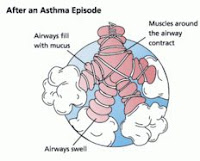 Asthma is a disease that causes the airways of the lungs to swell and narrow, leading to wheeze, shortness of breath, chest tightness, and cough. Asthma is the most common chronic lung disease, affecting up to 10% of adults and 30% of children.
Asthma is a disease that causes the airways of the lungs to swell and narrow, leading to wheeze, shortness of breath, chest tightness, and cough. Asthma is the most common chronic lung disease, affecting up to 10% of adults and 30% of children.This Japanese study aimed to determine patterns of factors preceding asthma exacerbations in a real-world setting. The prospective study included 190 patients who had experienced near-fatal asthma exacerbation. Cluster analysis was performed using asthma symptoms over the 2-week period before admission.
Three distinct clusters of symptoms were defined:
Cluster A (42%):
- rapid worsening within 7.4 hours from moderate attack to admission
- young to middle-aged patients with low body mass index (BMI)
- tendency to depression
- stopped anti-asthma medications, smoked
- hypersensitive to environmental triggers and furred pets
Cluster B (40%):
- fairly rapid worsening within 48 hours
- mostly middle-aged and older
- relatively good inhaled corticosteroid (ICS) or ICS/long-acting beta-agonist (LABA) compliance
- low perception of dyspnea
Cluster C (18%):
- slow worsening over 10 days before admission
- high perception of dyspnea
- smokers
- chronic daily mild-moderate symptoms
To reduce severe or life-threatening asthma exacerbation, personalized asthma management plans should be considered for each cluster:
- Cluster A: Improvement of ICS and ICS/LABA compliance and cessation of smoking
- Cluster B: To compensate for low perception of dyspnea, asthma monitoring of peak expiratory flow rate and/or exhaled nitric oxide would be useful.
- Cluster C: Avoidance of environmental triggers, increase usual therapy, or new anti-type 2 response-targeted therapies should be considered.
Uncontrolled asthma: “What to do when asthma is not doing well?” (click to enlarge the image).
References:
Identification of patterns of factors preceding severe or life‐threatening asthma exacerbations in a nationwide study https://buff.ly/2Ck8uwY
Image source: Image source: FDA and Wikipedia, public domain.
No comments:
Post a Comment